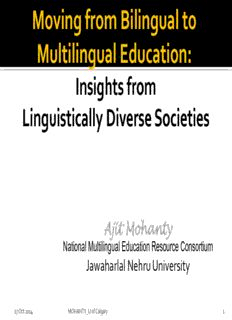
Moving from Bilingual to Multilingual Education PDF
Preview Moving from Bilingual to Multilingual Education
Moving from Bilingual to Multilingual Education: Insights from Linguistically Diverse Societies Ajit Mohanty National Multilingual Education Resource Consortium Jawaharlal Nehru University 27 Oct 2014 MOHANTY_U of Calgary 1 From BE to MLE: Movement beyond dominant v monolingual societies to complex multilingual ones MLE as a global movement v MLE broadly guided by theory & v principles of BE Problems in uncritical v appropriation of BE model in MLE 27 Oct 2014 MOHANTY_U of Calgary 2 Moving from BE to MLE: Some Issues in Conceptual Appropriation Uses & abuses of concepts (e.g. immersion’, v ‘balance’, BICS & CALP) Languages as solitudes vs. multilinguality v Linguistic Interdependence & Cross- v linguistic transfer (Multilingual oral traditions & movement between languages) & Early development of metalinguistic and cross- linguistic awareness & Early emergence of CALP-like proficiency 27 Oct 2014 MOHANTY_U of Calgary 3 Why was MLE necessary? The post-colonial hangover in the multilingual ¡ world: Imposed homogenization of the nation states and the identity aspirations of the communities in Africa and Asia The dominance of the Colonial Languages: ¡ Linguistic Imperialism & the “Killer Languages” Education of the marginalized: the God that ¡ Failed: Huge wastage in the system of education The compulsions of new democracies ¡ 27 Oct 2014 MOHANTY_U of Calgary 4 Hesitant Beginnings & Shifting Paradigms in Minority Education: India & Nepal Bilingual Transfer Models & Mother Tongue based ¡ Textbooks (1980 – 2001) International Initiatives and the Fortuitous beginning of ¡ MLE (2004) Early Experimental Programs in two Indian states (2005 ¡ – 2007): Compromises with theory & lapses in practice Experimental MLE program in post-monarchy Nepal ¡ New policy Initiatives in India: NCF, 2005, RTE, 2009 ¡ Nepal’s MLE Policy 2009 (Skutnabb-Kangas & Mohanty) ¡ & the new constitutional initiatives MLE Policy in Odisha (2014), India ¡ § 3372 MOTHER TONGUES (1576 listed, 1796 as ‘other’ languages) § 300 – 400 LANGUAGES (PLSI: 780) § 22+1 OFFICIAL LANGUAGES § 87 LANGUAGES OF PRINT MEDIA § 104 FOR RADIO BROADCASTING § 81/41 IN PRIMARY EDUCATION (1970/98) § MINORITY LINGUISTIC GROUPS>20% in half of the Districts Language, Power & Hierarchy: ‘Multilingualism of the Unequals’ ‘Linguistic Double Divide’ (Mohanty, 2004, 2010,) MULTILINGUALISM: THE DOUBLE-‐DIVIDE • Dominant DOMINANT Language- LANGUAGES Vernacular Divide • Vernacular- MAJOR STATE LANGUAGES Minority (Other) Language Divide MINORITY LANGUAGES Mohanty (2010), IJSL. INDIGENOUS/MINORITY LANGUAGES JUSTIFICATION OF EDUCATIONAL FURTHER & THE VICIOUS CYCLE NEGLECT SOCIAL NEGLECT WEAKENING OF LANGUAGES ¡ Declining number of languages/media in schools ¡ MT education for tribal (indigenous) children < 1% ¡ English Medium schools -‐ Indian Language(s) taught as subject(s) ¡ Regional language medium schools – English as compulsory second language by grade 4 ¡ Hindi NOT taught as a compulsory subject in most states or taught as a third language from grade 5 Tribal Popula,on & Tribal languages in India • Tribal popula,on: 84.3 million(8.2%) • 623 Tribal Communi,es (ASI); 573 no,fied or Scheduled Tribes • 218 languages (159 excusive to the tribes) • Most tribal language do not have a script; wriOen in major regional language scripts
Description: